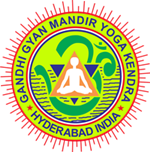Excretion of stool is a very essential aspect in the health protection. The digestion of the eaten food is very important. There should be neither indigestion nor constipation. The Yoga exercise that helps in this regard is Shankh prakshalan. The anus is in the shape of Shankh, a counch. The cleaning activity is called Prakshalan. Therefore the cleaning of anus is called Shankh prakshalan.
Shankh prakshalan Kriya is the most important process among all the Yogic cleaning kriyas, meant for the complete internal cleaning of the body. This is an activity, which is to be processed with great care. There are four asanas that are to be postured to get maximum benefit in this regard. Before practicing the asanas, saline warm water is drunk so that 30 to 40 ft long canal from mouth to anus is cleaned thoroughly.
As we require more water to clean a zigzag tube than a straight tube, similarly we require more water to clean the zigzag passage in our abdomen. This entire water is to be pushed into the stomach through the mouth, from stomach to small intestine, from small intestine to large intestine and from large intestine to the rectum. All the undigested particles of food and other accumulated wastes are pushed forward and conveniently let out along with the water through anus.
Before attempting to Shankh prakshalan, 5 to 6 liters of warm water either with one percent of salt or juice of 4 to 5 limes mixed should be kept ready.
The following four asanas are to be practiced in their order for Shankh prakshalan Kriya.
1. Sarpasan
2. Urdhva hastasan
3. Kati chakrasan and
4. Udar akarshanasan
Every time before attempting these asanas one glass of salted or limed warm water is drunk.
1. Sarpasan:
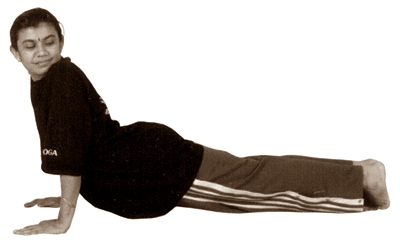
The body during this asan is like a hooded snake (sarp), so it is named as Sarpasan.
Procedure:
On a spread carpet keep the body flat on the stomach, place the palms at the side of the shoulders. Toes should be inverted towards the body. Now lift the body resting its weight on palms and toes. Knees should be lifted up a little. Breathing out turn the head over the right shoulder and look at the heels. Then bring back the head to the normal front position breathing in, then turn towards left and look at the heels. Repeat the same 3 – 5 times on either sides.
Advantages:
The water that is drunk passes through one and half foot long food-pipe and enters the stomach.
2. Urdhva hastasan:
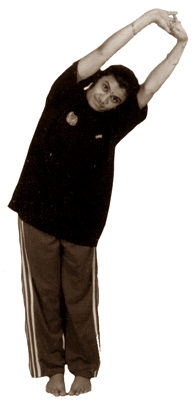
Hands (hasta) are raised up during this asan, so it is called Urdhva hastasan.
Procedure:
From Sarpasan, lift the waist upwards and bring the legs forward. Now the entire body stands erect. Raise the hands and interlock the fingers with palms upwards. Breathing out, bend towards right from the waist. Breathing in, slowly come back to the normal position. Repeat the same on the left side.
This is repeated alternate 3 to 5 times on both sides. During this exercise only the waist is bent. Neither elbows, nor knees are bent.
Advantages:
The water that is in the stomach is pushed along with the waste into the 25 to 30 ft long small intestine.
3. Kati chakrasan:
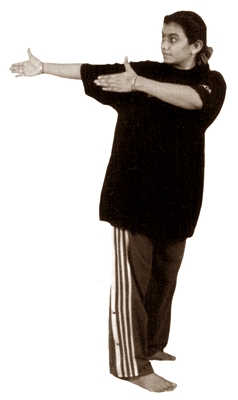
Kati means waist. The waist is moved in the shape of an arch in this asan, so it is called Kati chakrasan.
Procedure:
It is to be done in standing position. Keep the legs apart. Stretch both the hands in front keeping thumbs up. Breathing out, turn towards right so that the right hand is taken from side to extreme back and the left hand is brought across the chest to touch the right shoulder looking back. Breathing in, come to central position.
Similarly turn leftwards and look back. This is repeated 3 to 5 times alternatively on both sides.
Advantages:
The salt water with the undigested wastes that is in the small intestine is pushed further into 6 ft long large intestine.
4. Udar akarshanasan:
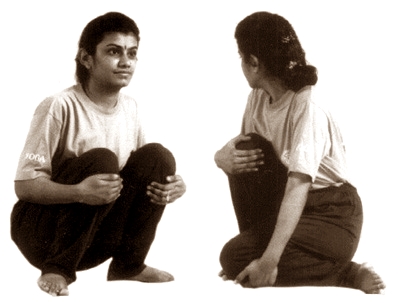
In this asan, the stomach (udar) is pressed with the thigh, so it is called Udar akarshanasan.
Procedure:
It is performed in the sitting (squatting) position on feet, as one sits while passing the stool in an Indian toilet. Place both the hands on both the knees. Legs are a foot apart. Bend the left knee towards the ground near the right heel, pressing the stomach with the right thigh. Breathing out, turn towards the right side and look back over the right shoulder. Breathing in come back to normal central position.
Similarly repeat on the left side. Repeat 3 to 5 times alternatively on both sides.
Advantages:
The salt water, that has traveled for about 35 to 40 ft, with all the wastes proceeds towards anus.
Points to be noted:
The above four asanas constitute one set. Before starting each set one glass of salt water is drunk. Generally excretion starts after completing 5 or 6 sets. At the beginning a bit solid waste starts coming out. During these exercises 4 to 5 times the water is excreted with impurities, later entire waste comes out along with the salt water. After that finally almost clean water is excreted as it is. It indicates the successful completion of the cleaning process.
The following rules are to be followed STRICTLY during Shankh prakshalan Kriya.
1. The above four asanas are to be practiced regularly for at least one week, before undertaking Shankh prakshalan Kriya, so that during prakshalan the asanas are exercised conveniently with ease.
2. Three days before undertaking Shankh prakshalan, Gaja karni or Jala dhauti Kriya should be practiced every morning before breakfast. This practice helps in drinking enough water during prakshalan and there will not be any vomiting sensation.
3. Nothing should be eaten after 4.00 pm a day earlier of undertaking Shankh prakshalan. Liquids may be taken if one feels so.
4. It takes half an hour to one hour for the completion of Shankh prakshalan Kriya and the salted or limed water cannot remain warm so long. Therefore the water should either be warmed at intervals or hot water is added so that warmth is maintained while drinking.
5. Those who don’t have the feeling of excreting the motion even after having 8 – 10 glasses of water, further drinking of water should be stopped for some time and the whole body should be rolled on the floor for some time. This will accelerate the main Kriya.
6. After the completion of the prakshalan some salt water remains in the stomach. To get it out, Jala dhauti Kriya is done using 5 to 6 glasses of fresh warm water without any salt.
7. After Jala dhauti, Jala neti Kriya should be done.
8. Every machine is lubricated when it is overhauled. Similarly after cleaning the internal parts of the body, pure ghee (melted butter) is to be consumed compulsorily. That completes the overhauling of the body.
Before undertaking Shankh prakshalan, pudding (Khichdi) with 100 gms. of rice, 100 gms of moongdal (Green Gram) with a pinch of salt is cooked and kept ready. After the Shankh prakshalan is completed, 75 grams of pure ghee (melted butter) is thoroughly mixed in the pudding and eaten belly full. The same pudding is prepared for the lunch and for the supper. On the whole nearly 250 gms. of ghee is to be consumed on that day.
The ghee produces energy in the body. Nothing should either to be eaten or drunk on that day except the prescribed pudding. Tea, coffee, milk, curd, buttermilk, fruits, curries, tobacco, alcohol, paan, pickles and smoking must STRICTLY be avoided for minimum 3 days after the Kriya. A little water may be taken. Light food is to be taken on the second and third day along with 150 gms. and 100 gms. of ghee respectively.
9. Bath can be taken before starting the prakshalan process. After Shankh prakshalan, bath should not be taken. Soon after the process, clothes are changed. Arogyamritam should be drunk (if available) and then Khichdi (pudding) should be eaten within 45 minutes.
10. All the parts of the body become very delicate when Shankh prakshalan Kriya is undertaken. Therefore 24 hours rest must be given to the body and mind. Complete rest is a MUST, no work should be attempted during rest. One should get up only either to eat the food or to attend the calls of nature. Physical rest on the following 2 days is much preferable. Fans or air conditioning should be avoided.
11. Persons suffering from ulcer, heart trouble and weakness; children, aged people, pregnant and those women who have their periods within a week should not attempt Shankh prakshalan. Persons with high B.P. should use limejuice instead of salt in the warm water. This prakshalan should be undertaken first time under the guidance of Yoga experts only.
12. In case of very weak people or people above 55 of age Laghoo (smaller version) Shankh prakshalan can be done, when the process is terminated after 1 or 2 excretions.
13. The process should not be undertaken on cloudy, rainy or when stormy winds blow and in a very hot or very cold season. It is best when done between 6.00 am – 10.00 am in Indian climate.
14. During this kriya, stool excretes with great force, so toilet should be made available for passing the stool immediately.
15. Sexual activity should be avoided a day before and 5 days after Shankh prakshalan Kriya as the inner organs become very sensitive.
16. At the time of performing Shankh prakshalan the required things should be kept ready which include, 6-7 ltrs of warm saline (lime) water, glass, jug, jalaneti pot, towel, napkin, soap (to wash the hands), Khichdi (with ghee) and undisturbed toilet facility with flowing water.
17. Following the above rules Shankh prakshalan Kriya can be performed once in 3-4 or 6 months.
Advantages:
If it is done according to the prescribed procedures there are a number of advantages. Internal organs including stomach, liver, kidneys, intestines are cleaned hence their diseases are brought under control. Gastric trouble, acidity, indigestion, constipation etc. are totally eradicated. The fat accumulated in the stomach and waist is reduced. This Kriya also helps in curing chronic diseases and disabilities like diabetes, asthma, eczema etc. Skin becomes brighter as the blood is purified. High blood cholesterol and high lipid levels are brought to normal.
![]()
Sarpasan, Urdhva hastasan, Kati chakrasan and Udar akarshanasan form one set.
They influence all the organs & parts of the body. Therefore after consuming one glass of fresh water or a cup of Arogyamritam, one should practice this set of exercises three or four times regularly everyday.
This is highly useful for entering into the higher Sadhana of meditation as it recharges the body and mind.
![]()
